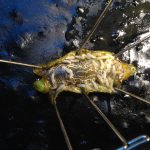
This gallery contains 6 photos.
Just thought I would post a few photos of some of the parasites I’ve studied recently.


This gallery contains 6 photos.
Just thought I would post a few photos of some of the parasites I’ve studied recently.
For those of us interested in the minutae and details of Myxozoan biology, a very interesting paper was published in PNAS back in early December. Sally Chang and company seem to have demonstrated beyond a reasonable doubt that the Myxazoa are indeed Cnidarians, and further, that the Myxozoa are sisters with Polypodium hydriforme, an intracellular Cnidarian parasite which is the only member of the only genus of the family Polypodiidae. Even further, together, the Myxozoa and P. hydriforme are sisters to the Medusazoa. All super interesting phylogeny.

Polypodium hydriforme, a Cnidarian intracellular parasite that has retained free living characteristics such as tentacles, a mouth, and a gut.
For those not interested in the phylogeny of bizarre fish parasites, there’s something else in that paper which might catch your interest: The Myxozoa have crazy small genomes. Well, one Myxozoan, Kudoa iwatai, but let’s say it’s representative (who wants to team up and sequence M. cerebralis?). Chang et al. measured K. iwatai‘s genome at 22.5Mb. The smallest known animal genome belongs to Pratylenchus coffeae at 19.67Mb. For comparison, Caenorhabditis elegans‘ genome is 100Mb, and Drosophila melanogaster’s is 130Mb. So, 22.5Mb is pretty dang small. Chang et al reason that the Myxozoa ditched a bunch of genes they didn’t need for their parasitic lifestyle, and back that up by comparing K. iwatai‘s genome to P. hydriforme’s, which is about 561Mb, and that of Hydra magnipapillata at 1005Mb. It adds up. P. hydriforme is an obligate intracellular parasite, but it has retained a mouth, a gut, and other tissues associated with free-living Cnidarians. Even more interesting, it seems that these small genomes are the result of genome degradation. K. iwatai‘s genome has shrank since it split with P. hydriforme. It seems that the more “parasitic” an organism’s body plan is, the smaller it’s genome. Remember P. coffeae up there with the smallest animal genome? It’s a parasitic nematode. Contrast that to C. elegans, a free living nematode.
This raises the question: what selective pressures have led to a shrinking genome? What benefit does completely deleting a gene confer that’s greater than simply deactivating it? And herein lies the rabbit-hole I’ve found myself tunneling down today. On the surface it makes fine sense, why carry around extra baggage? Endoparasites live awash in their hosts’ gene products. I certainly don’t keep instruction manuals around for things I don’t need to use or do anymore. But of course, evolution doesn’t work that way, no ancestral K. iwatai ever decided to shorten its genome. No, there must be some selective pressure on genome size.
Fortunately for curious minds, we aren’t the first to ask this question. Bacteriologists have noticed this trend as well. The sizes of bacterial genomes are more closely related to the number of genes they contain than the genomes of other groups, and parasitic bacteria have smaller genomes than free living bacteria. There have even been studies where bacteria were grown for many generations in metabolite rich media and evolved reduced genomes. The relationship between parasitism and genome size in bacteria is well documented. Here, the consensus seems to be that parasitic bacteria become more efficient by deleting segments of their genomes and thus not wasting energy and material on producing unneeded DNA, RNA, and gene products.
Is the benefit conferred by not producing the nucleic acids really great enough though that these genes are lost completely, as opposed to being turned off? If so, what leads to some organisms having absurdly large genomes, like the amoeba Polychaos dubia with a genome of 670Gb (yes that’s a G for giga!)? And while this explanation fits well for bacteria, which have a highly efficient system for deleting broken and invasive DNA, how do things work for higher organisms (like nematodes and Cnidarians?). How long does it take for higher parasites to lose free-living associated genes? How might genome degradation be associated with the fantastically interesting R/avr gene relationships between plants and plant pathogens? Could genome degradation in pathogens of non-plant hosts hint at similar mechanisms of immune defense at work? Does this trend hold true for ectoparasites?
Why did I choose Et in Arcadia Ego for the tagline of my website?
Arcadia, home of the god Pan in greek mythology, was a pastoral and sparsely populated region of ancient Greece. Idealized as a pure, rural utopia by urban, Hellenistic Greeks, by the time of the Renaissance it’s name had become synonymous with the pristine beauty of unspoiled wilderness and the idyllic simplicity of pastoral life. works by Guercino and Nicolas Poussin, both titled Et in Arcadia Ego (after a line from Virgil’s Eclogues) which translates as “I too [was] in Arcadia”, remind us that Death exists even in such a beautiful and joyful place as the earthly paradise of Arcadia.
This reminds me very much of disease ecology. Looking out over gorgeous mountain meadows and rolling headwater streams on a spring day, “diseased” is probably not a word one would use to describe the scene. However, pathogens and parasites are ubiquitous members of ecological communities, often acting “behind the scenes” to help shape the communities and ecosystems around us. Et in Arcadia Ego is a reminder that disease is an important part of even the most beautiful and vibrant ecosystems. It’s also a reference to my love of wild places, and a nod to one of my favorite books.
.jpg/300px-Nicolas_Poussin_-_Et_in_Arcadia_ego_(deuxi%C3%A8me_version).jpg)
Et in Arcadia ego – Nicolas Poussin (1638)